厦门大学:《结构化学 Structural Chemistry》课程教学资源(课件讲稿)Chapter 3 Molecular symmetry and symmetry point group
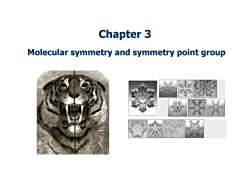
Chapter 3 Molecular symmetry and symmetry point group
Chapter 3 Molecular symmetry and symmetry point group
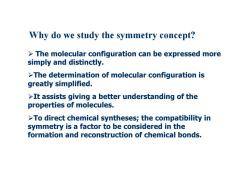
Why do we study the symmetry concept? >The molecular configuration can be expressed more simply and distinctly. >The determination of molecular configuration is greatly simplified. >It assists giving a better understanding of the properties of molecules. >To direct chemical syntheses;the compatibility in symmetry is a factor to be considered in the formation and reconstruction of chemical bonds
The molecular configuration can be expressed more simply and distinctly. The determination of molecular configuration is greatly simplified. It assists giving a better understanding of the properties of molecules. To direct chemical syntheses; the compatibility in symmetry is a factor to be considered in the formation and reconstruction of chemical bonds. Why do we study the symmetry concept?
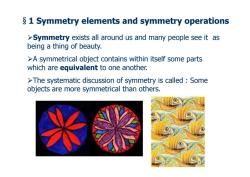
1 Symmetry elements and symmetry operations >Symmetry exists all around us and many people see it as being a thing of beauty. >A symmetrical object contains within itself some parts which are equivalent to one another. >The systematic discussion of symmetry is called Some objects are more symmetrical than others
§1 Symmetry elements and symmetry operations Symmetry exists all around us and many people see it as being a thing of beauty. A symmetrical object contains within itself some parts which are equivalent to one another. The systematic discussion of symmetry is called : Some objects are more symmetrical than others
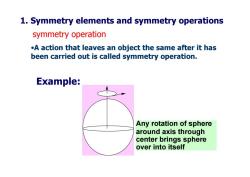
1.Symmetry elements and symmetry operations symmetry operation .A action that leaves an object the same after it has been carried out is called symmetry operation. Example: Any rotation of sphere around axis through center brings sphere over into itself
symmetry operation •A action that leaves an object the same after it has been carried out is called symmetry operation. Any rotation of sphere around axis through center brings sphere over into itself Example: 1. Symmetry elements and symmetry operations
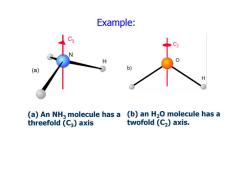
Example: 'b) (a)An NH3 molecule has a (b)an H2O molecule has a threefold (C3)axis twofold (C2)axis
(b) an H2O molecule has a twofold (C2) axis. (a) An NH3 molecule has a threefold (C3) axis Example:
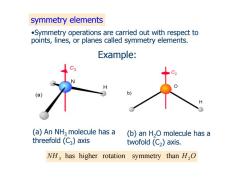
symmetry elements .Symmetry operations are carried out with respect to points,lines,or planes called symmetry elements. Example: (a)An NH2 molecule has a (b)an H2O molecule has a threefold(C3)axis twofold (C2)axis. NH,has higher rotation symmetry than H,O
(b) an H2O molecule has a twofold (C2) axis. (a) An NH3 molecule has a threefold (C3) axis NH 3 has higher rotation symmetry than H2O Example: •Symmetry operations are carried out with respect to points, lines, or planes called symmetry elements. symmetry elements
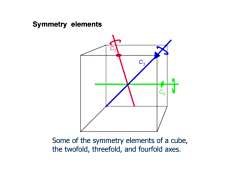
Symmetry elements 3 Some of the symmetry elements of a cube, the twofold,threefold,and fourfold axes
Some of the symmetry elements of a cube, the twofold, threefold, and fourfold axes. Symmetry elements
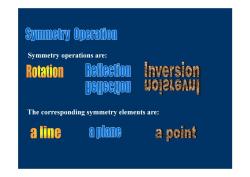
mmetry Operation Symmetry operations are: Rotation Reflection hversion B6I6600u 012乳6AU The corresponding symmetry elements are: a line a point
Symmetry operations are: The corresponding symmetry elements are:
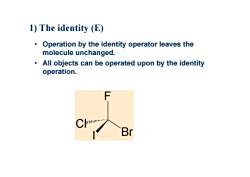
1)The identity (E) Operation by the identity operator leaves the molecule unchanged. All objects can be operated upon by the identity operation. Br
I F Cl Br • Operation by the identity operator leaves the molecule unchanged. • All objects can be operated upon by the identity operation. 1) The identity (E)
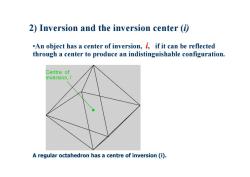
2)Inversion and the inversion center (i) .An object has a center of inversion,i,if it can be reflected through a center to produce an indistinguishable configuration. Centre of inversion,i A regular octahedron has a centre of inversion(i)
2) Inversion and the inversion center (i) •An object has a center of inversion, i, if it can be reflected through a center to produce an indistinguishable configuration. A regular octahedron has a centre of inversion (i)
按次数下载不扣除下载券;
注册用户24小时内重复下载只扣除一次;
顺序:VIP每日次数-->可用次数-->下载券;
- 厦门大学:《结构化学 Structural Chemistry》课程教学资源(课件讲稿)Chapter 2 Atomic Structure.pdf
- 厦门大学:《结构化学 Structural Chemistry》课程教学资源(课件讲稿)Chapter 1 The Basic Knowledge of Quantum Mechanics(讲授:曹泽星、蒋亚琪).pdf
- 厦门大学:《量子化学 Quantum Chemistry》课程电子教案(教学课件)Chapter 9 多原子的半经验方法 Semi-experimental method for polyatomic molecular.ppt
- 厦门大学:《量子化学 Quantum Chemistry》课程电子教案(教学课件)Chapter 8 共轭分子的结构与性能 Ab initio technique for polyatomic molecular.pdf
- 厦门大学:《量子化学 Quantum Chemistry》课程电子教案(教学课件)Chapter 7 简单分子轨道理论 Elementary molecular orbital(MO)theory.pdf
- 厦门大学:《量子化学 Quantum Chemistry》课程电子教案(教学课件)Chapter 6 分子的对称性与对称群 Molecular symmetry and symmetric group.pdf
- 厦门大学:《量子化学 Quantum Chemistry》课程电子教案(教学课件)Chapter 5 原子结构 Atomic structure.pdf
- 厦门大学:《量子化学 Quantum Chemistry》课程电子教案(教学课件)Chapter 4 角动量与自旋 Angle momentum and spin.ppt
- 厦门大学:《量子化学 Quantum Chemistry》课程电子教案(教学课件)Chapter 3 矩阵与算符 Matrix and operator.ppt
- 厦门大学:《量子化学 Quantum Chemistry》课程电子教案(教学课件)Chapter 2 简单量子力学体系 Rudimental quantum mechanics system.ppt
- 厦门大学:《量子化学 Quantum Chemistry》课程电子教案(教学课件)Chapter 1 Schrödinger 方程 Schrodinger equation.ppt
- 中国科学技术大学:《高分子化学》课程教学资源(课件讲稿)第六、七、八、九章 离子聚合、开环聚合、链式共聚合反应、配位聚合、聚合物的化学反应(主讲:刘世勇).pdf
- 和频光谱在生物膜等生物界面中的应用 In situ molecular level studies on membrane related peptides and proteins in real time using sum frequency generation vibrational spectroscopy.pdf
- 上饶师范学院:《无机化学》课程电子教案(课件讲稿)第二十二章 镧系元素和锕系元素.pdf
- 上饶师范学院:《无机化学》课程电子教案(课件讲稿)第二十一章 过渡元素(二).pdf
- 上饶师范学院:《无机化学》课程电子教案(课件讲稿)第二十章 过渡元素(一).pdf
- 上饶师范学院:《无机化学》课程电子教案(课件讲稿)第十八章 铜、锌副族.pdf
- 上饶师范学院:《无机化学》课程电子教案(课件讲稿)第十七章 碱金属与碱土金属.pdf
- 上饶师范学院:《无机化学》课程电子教案(课件讲稿)第十四章 氮族元素.pdf
- 上饶师范学院:《无机化学》课程电子教案(课件讲稿)第十五章 碳族元素(碳、硅、硼).pdf
- 厦门大学:《结构化学 Structural Chemistry》课程教学资源(课件讲稿)Chapter 4 The structure of diatomic molecules.pdf
- 厦门大学:《结构化学 Structural Chemistry》课程教学资源(课件讲稿)Chapter 5 The structure of polyatomic molecules.pdf
- 厦门大学:《结构化学 Structural Chemistry》课程教学资源(课件讲稿)Chapter 6 Polyatomic molecules(II).pdf
- 厦门大学:《群论及其在化学中的应用》课程教学资源(课件讲稿)Group Theory and Its Application to Quantum Chemistry - Introduction(主讲:曹泽星).pdf
- 厦门大学:《群论及其在化学中的应用》课程教学资源(课件讲稿)Part I 群论基础 Chapter 1 基本概念 Chapter 2 抽象群的结构.pdf
- 厦门大学:《群论及其在化学中的应用》课程教学资源(课件讲稿)Chapter 3 群的类分解 Chapter 4 商群与同态(Factor group & Homomorphism)Chapter 5 群的直积(Direct Product)Chapter 6 置换群(Permutation group/Symmetric group).pdf
- 厦门大学:《群论及其在化学中的应用》课程教学资源(课件讲稿)Chapter 7 Cayley定理 Chapter 8 线性向量空间(Linear vector spaces)Chapter 9 线性算符(Linear Operator)Chapter 10 群的表示.pdf
- 厦门大学:《群论及其在化学中的应用》课程教学资源(课件讲稿)Chapter 11 酉空间(Unitary Space)Chapter 12 表示的约化及其判据 Chapter 13 正交定理 The Orthogonality Relations Chapter 14 直积群的表示 Chapter 15 表示的分解 Chapter 16 投影算符(Projection Operator).pdf
- 《普通化学》课程电子教案(PPT教学课件)第9章 仪器分析基础.pptx
- 山西师范大学:《生物化学》课程教学大纲.pdf
- 山西师范大学:《生物化学实验》课程教学大纲.pdf
- 中国石油大学(华东):《结构化学》课程电子教案(教学课件)绪论(主讲:任浩).pdf
- 中国石油大学(华东):《结构化学》课程电子教案(教学课件)第四章 分子结构.pdf
- 中国石油大学(华东):《结构化学》课程电子教案(教学课件)第一章 量子力学基础.pdf
- 中国石油大学(华东):《结构化学》课程电子教案(教学课件)第二章 运动的量子理论.pdf
- 中国石油大学(华东):《结构化学》课程电子教案(教学课件)第六章 固体.pdf
- 中国石油大学(华东):《结构化学》课程电子教案(教学课件)第三章 原子结构和原子光谱.pdf
- 中国石油大学(华东):《结构化学》课程电子教案(教学课件)第五章 对称性.pdf
- 安徽建筑大学:材料与化学工程学院应用化学专业培养方案(2019版).doc
- 安徽建筑大学:材料与化学工程学院《高分子化学实验》课程教学大纲.pdf
